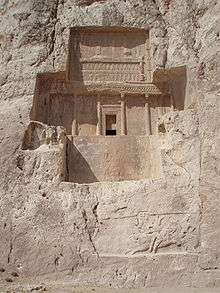Darius II
| Darius II | ||||||||||||||||||||||||||||||||||||
|---|---|---|---|---|---|---|---|---|---|---|---|---|---|---|---|---|---|---|---|---|---|---|---|---|---|---|---|---|---|---|---|---|---|---|---|---|
|
The Great King of Persia Pharaoh of Egypt | ||||||||||||||||||||||||||||||||||||
 Prospective tomb of Darius II of Persia in Naqsh-e Rustam. | ||||||||||||||||||||||||||||||||||||
| King of Persia and Pharaoh of Egypt | ||||||||||||||||||||||||||||||||||||
| Reign | 423–404 BC | |||||||||||||||||||||||||||||||||||
| Predecessor | Sogdianus | |||||||||||||||||||||||||||||||||||
| Successor |
Artaxerxes II as King of Persia Amyrtaeus as Pharaoh of Egypt
| |||||||||||||||||||||||||||||||||||
| Died | 404 BC | |||||||||||||||||||||||||||||||||||
| Spouse | Parysatis | |||||||||||||||||||||||||||||||||||
| Issue |
Artaxerxes II Cyrus the Younger Ostanes | |||||||||||||||||||||||||||||||||||
| House | Achaemenid | |||||||||||||||||||||||||||||||||||
| Father | Artaxerxes I | |||||||||||||||||||||||||||||||||||
| Mother | Cosmartidene of Babylon | |||||||||||||||||||||||||||||||||||
Darius II (Old Persian: Dārayavahuš), was king of the Persian Empire from 423 BC to 404 [1] or 405 BC.[2]
The Elephantine papyri mention Darius II as a contemporary of the high priest Johanan of Ezra 10:6.[3][4]
Artaxerxes I, who died on December 25, 424 BC, was followed by his son Xerxes II. After a month and a half Xerxes II was murdered by his brother Secydianus or Sogdianus (the form of the name is uncertain). His illegitimate brother, Ochus, satrap of Hyrcania, rebelled against Sogdianus, and after a short fight killed him, and suppressed by treachery the attempt of his own brother Arsites to imitate his example. Ochus adopted the name Darius (Greek sources often call him Darius Nothos, "Bastard"). Neither the names Xerxes II nor Sogdianus occur in the dates of the numerous Babylonian tablets from Nippur; here effectively the reign of Darius II follows immediately after that of Artaxerxes I.[1]
Historians know little about Darius II's reign. A rebellion by the Medes in 409 BC is mentioned by Xenophon. It does seem that Darius II was quite dependent on his wife Parysatis. In excerpts from Ctesias some harem intrigues are recorded, in which he played a disreputable part.[1]
As long as the power of Athens remained intact he did not meddle in Greek affairs. When in 413 BC, Athens supported the rebel Amorges in Caria, Darius II would not have responded had not the Athenian power been broken in the same year at Syracuse. As a result of that event, Darius II gave orders to his satraps in Asia Minor, Tissaphernes and Pharnabazus, to send in the overdue tribute of the Greek towns and to begin a war with Athens. To support the war with Athens, the Persian satraps entered into an alliance with Sparta. In 408 BC he sent his son Cyrus to Asia Minor, to carry on the war with greater energy. Darius II died in 404 BC, in the nineteenth year of his reign, and was followed as Persian king by Artaxerxes II.[1]
Issue
Prior to his accession, Darius II was married to the daughter of Gobryas. With the daughter of Gobryas, Darius II had four sons, one of whom fathered Artabazanes, who served as King of Media Atropatene in the second half of the 3rd century BC.[5][6][7]
- By Parysatis (his half-sister)
- Artaxerxes II
- Cyrus the Younger
- Oxathres or Oxendares or Oxendras
- Artoxexes
- Ostanes
- Amestris wife of Teritouchmes & then Artaxerxes II
- & seven other unnamed children
- By other wives
- Artostes
- The unnamed satrap of Media at 401 B.C.
See also
References
- 1 2 3 4

- ↑ Brill's New Pauly, "Darius".
- ↑ Pritchard, James B. ed., Ancient Near Eastern Texts Relating to the Old Testament, Princeton University Press, third edition with supplement 1969, p. 492
- ↑ Bezalel Porten (Author), J. J. Farber (Author), C. J. F. Martin (Author), G. Vittmann (Author), The Elephantine Papyri in English (Documenta Et Monumenta Orientis Antiqui, book 22), Koninklijke Brill NV, The Netherlands, 1996, p 125-153.
- ↑ ARTABAZANES, Encyclopedia Iranica
- ↑ García Sánchez, M (2005): "La figura del sucesor del Gran Rey en la Persia Aqueménida", in V. Troncoso (ed.), Anejos Gerión 9, La figura del sucesor en las monarquías de época helenística.
- ↑ Hallock, R (1985): "The evidence of the Persepolis Tablets", in Gershevitch (ed.) The Cambridge History of Iran v. 2, p. 591.
Darius II Born: ?? Died: 404 BC | ||
| Preceded by Sogdianus |
The Great King of Persia 423–404 BC |
Succeeded by Artaxerxes II |
| Pharaoh of Egypt 423–404 |
Succeeded by Amyrtaeus | |
| Wikimedia Commons has media related to Darius II. |